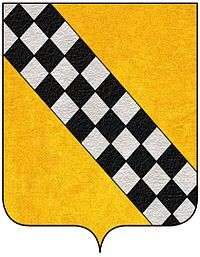Adorno family
The Adorno family was a patrician family of the Republic of Genoa, with the branches of Botta in Milan and Adorno Pastorino in Turin, several of whom were Doges of the republic.[1] The family is considered one of the most influential in the history of the republic.[2]

The elder branch was extinct in 1634, and the titles, fiefdoms and surname were inherited by the Botta family of Milan, which has since been called Botta Adorno. The Botta family has been attested since 1298, with the progenitor Simone Botta, a citizen of Cremona. The Botta Adorno became extinct in 1882. The lines of the Adorno of la Val Pasturezza were progenitors of the Pastorinos.
They were generally rivals of the Fregoso family. Both families rose to power in the late 14th century.[3]
The first of the Adorno doges, Gabriele Adorno, is also the tenor role in Giuseppe Verdi's opera Simon Boccanegra.[4]
History
According to an ancient legend, reported by Amedeo Pescio, this family originated from a nobleman of German origin, who in the 12th century, came on pilgrimage with many other pilgrims to Genoa, because they believed that they could arrive in the Holy Land through the sea, waiting for the same prodigy that had happened to Moses in the Red Sea. After days of long waits, almost all returned to Germany, while some remained in Genoa, including this nobleman named Adorno. However, it is more likely that the family originated and drew its name from the township of Adorno, near Taggia, in the far Riviera of Ponente; it is along the valley of Pasturezza,then called Vallechiara,that the family began to own several dwellings. A first memory of the house can be found in a notary document concerning Anna Happy Widow of Adorno, drawn up on 12 January 1186.
The same character can also be found in another notary document of October 15, 1210; Barisone and Pietro (1212), from whom Barisone, derive the later branches of the family, are born. In the early days it lived with a profit of merchandising, so much so that it accumulated great riches, which were the basis of the subsequent power.
According to some historians, Barisone meant a nickname (last name) or a first name. Some assume that there was a kinship relationship between this Barisone Adorno and Barisone I Kings of Sardinia. Other historical news about Barisone Adorno can be seen in France, in the monastery of Chiaravalle (later a state prison), in which there is a stained glass window that depicted a knight presented by St. Bernard Abbot of Chiaravalle to Pope Eugenio III in the year 1148, on the return of the second crusade, with the inscription of the name: Barisone Adorno. From the family trees, this Barisone Adorno (in some notary acts simply called Adorno) turns out to be the third son of Barisone of Lacon Serra, Judge of Arborea, then King of Sardinia, and Pelegrina Lacon Caller.
There are many branches in which the Adorno house was divided, one of which, that of the Counts of Montegil, vissé in Spain. The old house of campanaro, of which Nicolò, in the 14th century, married Margherita Adorno, daughter of Adornino of William and sister of the dogi Giorgio and Antoniotto senior,replaced his children with the most prestigious surname of their mother.
Other branches also settled in Germany and Sicily, in the cities of Messina, Syracuse and Palermo, until its extinction in 1846. In Messina the Adorno enjoyed nobility in the period from the 16th to the 17th century; he remembers the noble Antonio Adorno who is mentioned in the Noble Mastra del Mollica of the year 1600 in the fourteenth list. Another branch is found in Syracuse, belonging to the bourgeois class and awarded the senatorial position, as representative of the city class; Carmelo Adorno held this post in 1746, 1754 and 1757. Later this family entered the city nobility, and Giovanni Adorno served as Senator in 1796. In Syracuse there were other Adorno, but worthy of remembrance is Giorgio Adorno, a Genoese patrician, knight of the Order of Malta, who died in Sicily after 18 September 1565; this George left a lineage still residing in Syracuse who later became related to the Avolio (even today there are testimonies in the court of the Avolio located on the island of Ortigia). Other descendants still alive are in Floridia and Syracuse.
Principal members
Doges
- Gabriele Adorno (1320–1398)
- Antoniotto Adorno (1340–1398)
- Giorgio Adorno (1350 – 1430)
- Raffaele Adorno (1375 – 1458)
- Barnaba Adorno (1385 – 1459)
- Prospero Adorno (1428 – 1486)
- Agostino Adorno (1488-1499)
- Antoniotto II Adorno (c. 1479 - 1528)
Castles and palaces of the Adornos
- Doge's Palace, Genoa
- Borgo Adorno
- Castello della Pietra
- Castello di Gabiano
- Castello di Bolzaneto
- Il castello Adorno in Silvano d'Orba
- Castelletto di Branduzzo
- Castello di Savignone
- Cortachy Castle in Scotland (according to Italian Wikipedia)
- Palazzo Adorni Braccesi
Palazzo Adorno di Lecce; Palazzo Adorno di Genova;Palazzo Cattaneo Adorno;Palazzo baronale di Caprarica di Lecce (Puglia)
See also
References
- Oren Margolis (2016). The Politics of Culture in Quattrocento Europe: René of Anjou in Italy. ISBN 0191082198.
- "Adorno Family | ruling family of Genoa". Encyclopedia Britannica. Retrieved 2020-07-23.
- Dana Facaros; Michael Pauls (2006). Italian Riviera and Piedmont. p. 132. ISBN 1860113087.
- Roger Parker (2007). The New Grove Guide to Verdi and His Operas. p. 165. ISBN 0199727813.
